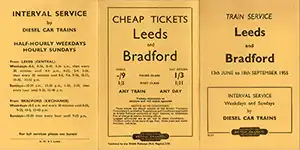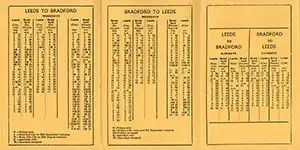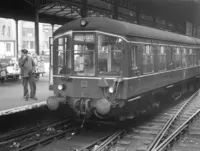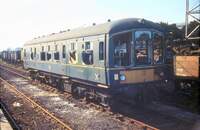Derby Lightweight (Red Triangle) 2-car DMUs
Operations
The sets principally worked on services between Bradford Exchange, Leeds Central and Harrogate, introduced on June 14th, 1954.
The first set, E79000 / E79500, ran from Derby to Melbourne and back on test on March 30, 1954. Tests continued, including to Trent, Leicester and on the 14th April to Cricklewood and on the 22nd April to Chinley via Millers Dale and back via Dore. On that day the second set was due to on a test run to Trent and back.[1]

E79502 was displayed in a rolling stock and equipment exhibition at Willesden depot from May 25 to June 4th 1954 in connection with the International Railway Congress. As seen in the image it sat in the roundhouse between a London Transport vehicle and a Mark One coach.
The units were tested on other future DMU routes too. On Tuesday 19th October 1954 79007/79507 headed north via Ripon to Tyneside, carrying reporting number 92 on the centre lamp bracket, arriving at Gosforth Car Sheds in the afternoon. The next day it made a performance trial runs to assist in planning for the Newcastle - Middlesbrough services planned to be dieselised the following year. It departed Newcastle at 9.35am for Middlesbrough, calling at Sunderland and West Hartlepool. It returned from Middlesbrough at around 11.40am, and another round trip was made the following day.[2]
Operational Problems
The first real trouble that first generation DMUs experienced was caused by bad weather at the end of January 1955. This had a serious effect on the operations of the sets. The trouble was from burst radiators and piping due to the cold, and failure of the sanding gear. At least two sets had to be pushed into Bradford by steam locos when they were unable to grip the rails, services were cancelled, and one train took 1 hour 40 mins for the nine miles from Leeds to Bradford. The climax of the failures was reached on the 28th and 29th January, but on the latter date the authorities were prepared for trouble and the interval services were kept going with the aid of five steam locos on two coach trains form Leeds to Bradford. Efforts were made to keep the Harrogate services diesel worked by 79000/500 (which was in bad condition), 79002/79502 and 79007/79507. The situation was aggravated by a N7 developing a hot box.
There was a second spell of bad weather in 1955, but the sets stood up to it far better, with normally four being in service instead of the required five. It was possible to maintain the full service, as well as couple two-units to form the 17:05 Bradford - Leeds and 17:36 return. Unit 79001/79501 was in Derby works for modification at this time.
Around Easter 1955 a set from Bradford Exchange with 40 passengers arrived late at Leeds Central. Due to an oversight, the connection for London had already left. It was decided the DMU should proceed to Wakefield, and the 10 miles were covered in 11 mins. The London train was held at Wakefield, and was only 5 mins late dep from there.
Over the Easter 1955 weekend all seven sets managed to keep running, although they were supplemented by push-pull trains between Leeds and Bradford. 79001/501 was still in works for modification.
The 1955 strike saw a single set operate a shuttle service between Leeds and Bradford on Whit Monday, along with N1 69474 and 3 coaches. During the remainder of the strike period the service was worked entirely by one diesel train, either as a 2-car or 4-car. According to a newspaper report it was worked by one driver who, being near retirement had decided to work. He claimed one day to have made the round trip between Leeds & Bradford in 35 mins!
They were noted as being able to accelerate from 40mph to almost 50mph on the half mile up the 1 in 66 into Harrogate, before slowing for the 20mph station approach.
The diesel services in the Leeds-Bradford area was somewhat depleted in the summer of 1955 by up to two units at a time. These included 79003/79503, which went to Derby on the 20th June for modifications, and 79000/79500 (27th June - 1st July), 79002/502 (4th - 8th July), 79006/79506 (11th - 15th July) which were at York for tyre turning.
The timetable beginning June 13, 1955, is illustrated, this measured 5" x 3 3/8" when folded, and was card rather than paper.
79001/501 arrived back from Derby after a five month stay on the 25th June. To supplement the losses 79032/3 arrived at Bradford from Lincoln on 8th July, and the following week they were used to train crews on the conventional gearboxes on the Bradford - Halifax - Keighley lines. They went into regular service on the 16th July coupled to 79031 (loaned from Lincoln) and 79036 (loaned from Norwich to Lincoln to Bradford!) which arrived at Bradford on the 15th July. All these four cars were from power/trailer sets, but because of the severe gradients the trailers were left behind at Lincoln. These four cars, with their different control system, had to stick together, particularly when run as a 4-car set. The drivers were said to prefer these cars, with greater power and speed and it was also noted that they produced less smoke!
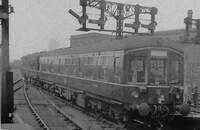
Complete with oil tail lamp, E79500 departs Leeds Central for Bradford one August evening in 1954. H Walshaw.
Set 79000/500 worked Ripon’s first regular diesel service on 19th September 1955, being worked by Bradford (GN) men. The winter 1955 timetable saw the 13:39 Harrogate - Leeds steam service replaced by a DMU at 13:36, and the 09:35 for Bradford extended to Ripon, the return leaving at 11:08.
On 5 October 1955 unit 79006/79506 failed on a Bradford to Ripon service on arrival, and the Ripon pilot J39 64859 propelled them for the return journey to Harrogate. On the 18 October 1955 79003 and 79501 were noted on the turn.[3]
The 1956 Whitsuntide holiday traffic to Knaresborough saw Newcastle sets 79152/328/510 and 79153/329/511 sent to augment the Bradford diesels, which were all running as 4-car sets.
Six special diagrams were in operation for the 1956 August Bank Holiday, when a half-hour service was run between Bradford and Knaresborough. The eight Bradford sets were made up into four 4-car sets, and the other two diagrams were covered by Newcastle sets 79153/328/511 and 79154/325/510. There were also two diagrams for steam specials from Leeds to Knaresborough. On the 7th August one diesel and both steam diagrams were dropped.
Teething Problems
As on all new vehicles, teething problems both major and minor came to light. The biggest problem was the wiring. Each two-car set had 2 ¼ miles of wiring and electrical faults were a common and difficult fault to trace. A large number of the faults affected the electro-pneumatic control system, and sets would have to be taken out of service until the fault was located and cleared. At one time only two sets were in working order, the services being worked with the assistance of steam trains. However, after some months experience each set went to Derby for modification. Little electrical trouble was found after that.
Two other electrical faults were found out the hard way, one being that the soldered tags would not stand up to the vibration and had to be replaced, and that the charging current was not high enough for the comparatively short journeys involved, so larger dynamos had to be fitted. Once the curse of the flat batteries had been overcome there was a definite improvement in service.
The riveted aluminium body had a tendency to shake itself to bits. This was due to the alloy rivets which sheared after the car had been in traffic for a time. Temporary repairs were made at the shed with nuts and bolts, and steel rivets were fitted on subsequent visits to Derby.
The connection between the engine and the oil cooler was originally made by means of rubber hose and clips. On occasions the oil caused the hose to free itself until it finally blew off, following which the whole of the engine oil would be deposited on the track. The connection was soon changed to pipes and unions!
A final minor problem was the sandboxes which would come adrift, and so these were all removed. Many of the pipework and electrical problems allegedly arose because the Carriage Works did not want to refer to the Mechanical Engineering side during construction.
When breakdowns occurred the staff were insufficiently trained on what to do, and the sets were rather harshly treated as the drivers, who had been selected through seniority rather than aptitude, and found it hard to adapt to this new traction.
The Sets in 1956/7
In the winter 1956/57 timetable, five two car sets were in use on Monday to Fridays (the only trains that were 4-cars were certain Saturday services) and the diagrams made intensive use of the cars, working between 05:35 and 23:39. Crews were from Leeds and Bradford, and they too were economically employed. At holiday times an intensive service was provided between Bradford and Knaresborough, a popular beauty spot four miles beyond Harrogate. On the ‘56 August Bank Holiday one set made fourteen trips between Bradford and Leeds, twelve between Leeds and Harrogate, and eight between Harrogate and Knaresborough. This was a total of 377 miles in 16 hours 25 minutes, and five other sets were used on similar duties at the same time.
The drivers on the DMU links would no longer normally drive steam engines, but to cover holidays and sickness a number of extra drivers were trained on the Lightweights and formed into a spare link on the steam side to be called upon as required. Only one of the diagrams returned a set to the shed at Bowling Junction at night, the rest were stabled at Bradford Exchange Station. Both these places had two 5,000 gallon fuel tanks equipped with electric pumps, allowing two cars to be filled together. These vehicles only had one heater per car, and there were often complaints of coldness. While originally the fuel oil supply for the heater was contained in a separate compartment of the main tank, it had been found that this ran out before the main tank, requiring an additional trip to the pumps. This was overcome by punching holes in the partition between the two tanks, forming a common supply. Figures quoted for the week ending 17th November 1956 showed vehicle 79006 completing 1,569 miles for a consumption of 259 gallons, while it's partner 79505 used 264 gallons. This gave a figure of 3 mpg for the two car set.
In early 1957 some Met-Camms were delivered to Bradford, and diesel services were extended on the 25th February, resulting in the reduction of Starbeck steam passenger diagrams from seven to four.
On the 15th May 1957 79002 was noted paired with 79501 operating the 8.35pm Bradford - Ripon.
Maintenance
The Leyland engines had given no trouble at all and replacements were only done due to ordinary wear and tear or due to unforeseen circumstances. One little incident was where a porters barrow was caught by the wind and caused two sets to be taken out of traffic. It blew into the path of one unit, while another was passing at the same time. The barrow was completely demolished, puncturing three of the four fuel tanks in the first set, and knocking off an oil filter on the other!
The first car to be sent for overhaul went to Derby in January 1957, and wheel turning and other light repairs were done at York Carriage Works. Engines were changed at the shed if necessary, but was not a regular practice. Example mileage's run up to 29th December 1956 were: 79002 141,340 miles; 79004 130,521 miles and 79007 158,726 miles. As far as was possible sets were kept to their original pairings.
At the time the 16 Bradford cars were the only ones fitted with torque converters, as all newer vehicles had been built with epicyclic gearboxes. The maintenance staff, who would only work on the diesels, considered the torque converters to be more reliable units and not as easily damaged as the gearboxes.
Being allocated to a former steam shed, there was problems with soot, ash and grime, and also whitewash which dripped from the walls.
Strict daily examinations were carried out on each car, with more detailed exams at multiples of 3,000 miles. The daily exams looked at:-
- general examination of car for loose and missing parts
- check engine oil levels
- check final drive oil levels
- with engine running:-
- check air pressure
- check horns
- check windscreen wipers
- check vacuum brakes
- adjust brakes if necessary
- check water level & engine radiators
Electrical
- check dynamo output
- check headlamp and car lighting
- check operation of final drives
- check heaters (if necessary remove and clean glow plugs)
- check throttle controls
- check operation of deadmans handle
- check engine stop & start control system
The more detailed mileage exams were as follows:-
3,000 Thorough inspection of whole Railcar, including grease and oil
points, and static test of hydraulic system.
6,000 Filters on all systems renewed. Engine sump oils renewed. Engine
speeds and tappet clearances checked.
12,000 Injection equipment tested. Final drives examined.
36,000 Removal of electrical equipment (dynamos, starter motors etc.)
for checking. Thorough examination of engines, transmissions and
drives.
The engines were changed for major overhaul between 100,000 and 120,000 miles.
Decline
In the years that followed the vehicles received almost no mentions in enthusiast publications suggesting that little out of the ordinary happened, and they settled in to give good service.
In September 1959 E79004 / E79504 operated diesel instruction specials over the Penistone branch, running on the 21st to 25th and 28th to 30th inclusive.[4]
Withdrawal
Despite their apparent success, more and more DMUs were built, at a time when the rail network was shrinking. Other types such as BRC&W sets (later known as Class 104s) could now be found on Leeds - Harrogate services. As there was then a surplus of sets, the sets were non-standard, could not be coupled to other types, and needed specialist spare parts, they were withdrawn in early 1964.
British Railway's first DMUs had spent less than ten years in service.
79504 was the first to go, withdrawn in the week ending January 11. In the week ending February 22 E79004/6 went, the remainder in the week ending February 29th. Some sets had been out of use for some time before withdrawal[5].
Disposal
The BR Rolling Stock Library Ledger FG07 gives the disposals as[6]:
79000 6234 13/64-0 5458 26/64-5 (King Norwich)
79001 6234 13/64-0 5491 22/64-4 BR Ranskill C&&W 8/1964
79002 6234 13/64-0 5458 26/64-5 (King Norwich ?)
79003 6234 13/64-0 5458 26/64-5 (King Norwich ?)
79004 6005 13/64-2 6005 16/64-4 BR York Works 6/1964
79005 6234 13/64-0 5491 22/64-4 BR Ranskill C&W 8/1964
79006 6005 13/64-2 6005 21/64-4 BR York Works 7/1964
79007 6234 13/64-0 5491 16/64-4 BR Ranskill C&W 6/1964
79500 6234 13/64-0 5529 13/66-5 Cox & Danks Wadsley Bridge (3/1966 Roger Silsbury Sales Sheets)
79501 6234 13/64-0 5491 22/64-4 BR Ranskill C&W 8/1964
79502 6234 13/64-0 5458 26/64-5 (King Norwich ?)
79503 6234 13/64-0 5458 26/64-5 (King Norwich ?)
79504 6005 11/64-2 6005 21/64-4 BR York Works 7/1964
79505 6234 13/64-0 5491 21/64-4 BR Ranskill C&W 7/1964
79506 6234 13/64-0 5458 26/64-5 (King Norwich ?)
79507 6234 13/64-0 5491 21/64-4 BR Ranskill C&W 7/1964
The data from the ledger shows the vehicle number, the stannox code from where the vehicle was condemned from, the accounting period for the condemnation (the year starting with 11/64), the stannox code for the location that the vehicle was either sold from/scrapped at - sold from to, the date of the disposal with the extra digit representing a disposal code (4 cut by BR staff, 5 cut by private contractors).
The three vehicles that were withdrawn early 79004/6/504 were in York Works (6005) when withdrawn and would be cut there in June/July. The remainder were withdrawn from Leeds District (6234).
On 9 April 1964 79001 + 79501, 79005, 79007 + 79507 were noted being towed through Doncaster behind Jubilee 45694[7], likely on their way to Ranskill C&W (5491) and 79505 was also probably in this formation. They were cut there between June and August.
Six vehicles - 79000, 79002 + 79502, 79003 + 79503 and 79506 - had at some point made their way to Doncaster Carriage Works (5458) from where they were sold for scrap in November 1964. As 79000 was photographed at Archie King's scrapyard at Hall Road, Trowse, Norwich, it is assumed that all six were sold there.
The final vehicle — E79500 — for some reason seems to have lingered longer than the others. It was sold from Sheffield Victoria (area) (5529) for scrap in March 1966 and the sales documentation shows it was sold to Cox & Danks Ltd Wadsley Bridge.
References
- ⋏ p139 May 1954 Railway Observer
- ⋏ p340 November 1954 Railway Observer
- ⋏ p362 November 1955 Railway Observer
- ⋏ p346 November 1959 Railway Observer
- ⋏ p438 August 1965 Railway Observer
- ⋏ emails John Hall to Stuart Mackay 4 and 8 November 2023
- ⋏ p218 July 1964 Railway Observer
The Railway Observer is the journal of the Railway Correspondence and Travel Society



